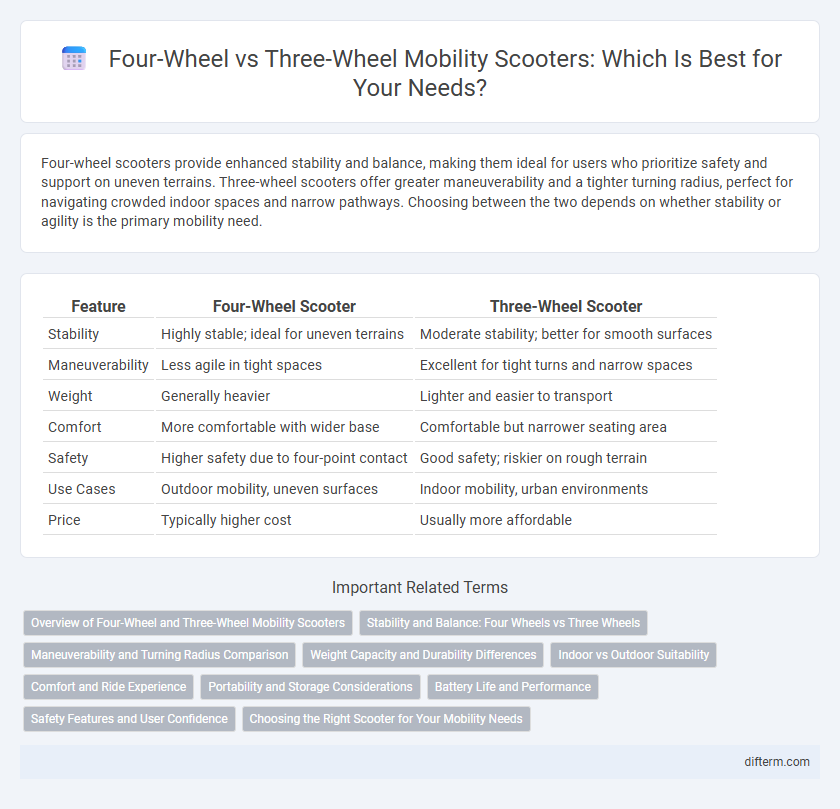Four-wheel scooters provide enhanced stability and balance, making them ideal for users who prioritize safety and support on uneven terrains. Three-wheel scooters offer greater maneuverability and a tighter turning radius, perfect for navigating crowded indoor spaces and narrow pathways. Choosing between the two depends on whether stability or agility is the primary mobility need.
Table of Comparison
| Feature | Four-Wheel Scooter | Three-Wheel Scooter |
|---|---|---|
| Stability | Highly stable; ideal for uneven terrains | Moderate stability; better for smooth surfaces |
| Maneuverability | Less agile in tight spaces | Excellent for tight turns and narrow spaces |
| Weight | Generally heavier | Lighter and easier to transport |
| Comfort | More comfortable with wider base | Comfortable but narrower seating area |
| Safety | Higher safety due to four-point contact | Good safety; riskier on rough terrain |
| Use Cases | Outdoor mobility, uneven surfaces | Indoor mobility, urban environments |
| Price | Typically higher cost | Usually more affordable |
Overview of Four-Wheel and Three-Wheel Mobility Scooters
Four-wheel mobility scooters offer enhanced stability and support, making them ideal for outdoor use and uneven terrain, while three-wheel scooters provide superior maneuverability and a tighter turning radius, suited for indoor and crowded spaces. The added wheel on four-wheel scooters increases weight and footprint but improves load capacity and balance, whereas three-wheel models are lighter and more compact, favoring portability. Battery life and motor power vary across models, with four-wheel scooters often equipped with more robust batteries for longer travel distances.
Stability and Balance: Four Wheels vs Three Wheels
Four-wheel scooters offer enhanced stability and balance due to their wider base and evenly distributed weight, reducing the risk of tipping over on uneven surfaces. Three-wheel scooters provide greater maneuverability and tighter turning radius but may require more skill to maintain balance, especially at higher speeds or on rough terrain. Users prioritizing safety and stability often prefer four-wheel models, while those seeking agility might choose three-wheel scooters.
Maneuverability and Turning Radius Comparison
Four-wheel scooters offer greater stability but have a larger turning radius, making them less agile in tight spaces compared to three-wheel scooters. Three-wheel scooters excel in maneuverability with a smaller turning radius, allowing smoother navigation through narrow aisles and crowded environments. Users seeking portability and sharp turns often prefer three-wheel models, while those prioritizing balance typically choose four-wheel scooters.
Weight Capacity and Durability Differences
Four-wheel scooters generally offer higher weight capacities, typically supporting up to 350 pounds or more, compared to three-wheel models that often support around 250 to 300 pounds. The extra wheels in four-wheel scooters contribute to enhanced stability and durability, making them suitable for users requiring robust performance on various terrains. In contrast, three-wheel scooters prioritize maneuverability but may sacrifice some durability and weight capacity due to their lighter frame and fewer support points.
Indoor vs Outdoor Suitability
Four-wheel scooters offer superior stability and weight distribution, making them ideal for outdoor terrain and uneven surfaces. Three-wheel scooters provide enhanced maneuverability and a tighter turning radius, suited for indoor use and confined spaces. Choosing between the two depends on prioritizing stability for outdoor mobility or agility for indoor navigation.
Comfort and Ride Experience
Four-wheel scooters provide enhanced stability and balance, offering a smoother and more comfortable ride on uneven surfaces compared to three-wheel scooters. The wider base of four-wheel models reduces wobbling, making them ideal for users seeking a steady and secure mobility solution. In contrast, three-wheel scooters excel in maneuverability but may sacrifice some ride comfort on rough terrain due to their narrower wheel configuration.
Portability and Storage Considerations
Four-wheel scooters offer greater stability but tend to be bulkier and heavier, making portability and storage more challenging compared to three-wheel scooters. Three-wheel scooters typically feature lighter frames and more compact designs, facilitating easier folding, transport, and storage in tight spaces like car trunks or closets. Consumers seeking mobility solutions with frequent travel or limited storage space often prefer three-wheel scooters for their enhanced portability and convenience.
Battery Life and Performance
Four-wheel scooters typically offer longer battery life due to larger battery capacity, supporting extended travel distances for users. In terms of performance, four-wheel scooters provide enhanced stability and weight distribution, resulting in smoother rides on uneven terrain compared to three-wheel models. Three-wheel scooters, while more compact and maneuverable, generally have shorter battery duration and slightly reduced performance on rough surfaces.
Safety Features and User Confidence
Four-wheel scooters provide enhanced stability due to their wider base and even weight distribution, reducing the risk of tipping and improving user confidence in various terrains. Three-wheel scooters offer greater maneuverability but may sacrifice some stability, making safety features such as anti-tip wheels and robust braking systems critical for user security. Advanced safety elements like LED lights, reflective strips, and ergonomic controls further boost rider confidence and ensure safer mobility experiences.
Choosing the Right Scooter for Your Mobility Needs
Four-wheel scooters offer enhanced stability and support, ideal for users requiring extra balance and outdoor use on uneven surfaces. Three-wheel scooters provide greater maneuverability and a tighter turning radius, making them suitable for indoor settings and navigating narrow spaces. Assessing your mobility needs based on terrain, balance, and portability will guide you in selecting the most appropriate scooter for daily activities.
four-wheel scooter vs three-wheel scooter Infographic

 difterm.com
difterm.com